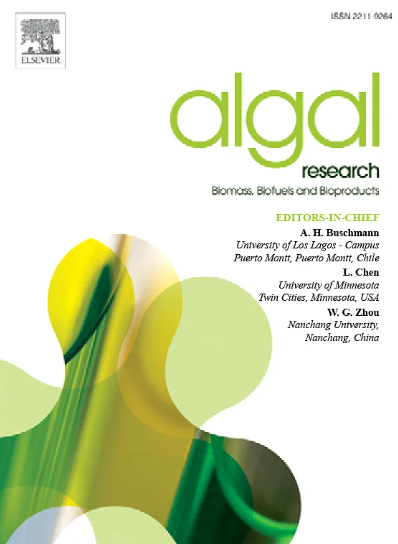通过优化自冷却平板光生物反应器中的混合率提高板金节肢动物的生产率
IF 4.6
2区 生物学
Q1 BIOTECHNOLOGY & APPLIED MICROBIOLOGY
Algal Research-Biomass Biofuels and Bioproducts
Pub Date : 2025-04-09
DOI:10.1016/j.algal.2025.104035
引用次数: 0
摘要
几十年来,Arthrospira platensis一直是人们的主食。而沟道池通常用于大规模养殖,封闭光生物反应器(pbr)提供更高的生产力和降低污染风险。混合速率是影响微藻生长和产量的关键因素。本研究考察了空气注入流速(0.17-0.27 vvm)(对应于表面气速0.00315-0.0050 m·s−1)对140 L自冷平板PBR中a . platensis生长、生产力和有效量子产率(f'q/f'm)的影响,该平板PBR具有红外反射薄膜涂层,可以被动控制温度并减少冷却时的能量需求。最佳气速为0.00389 m·s−1,平均产率为0.126 g·L−1·d−1。超过这个速度,在0.00426 m·s−1时,生产力没有显著增加,f'q/f'm也没有显著降低。然而,在0.00463 m·s−1和0.0050 m·s−1较高的气速下,f’q/f’m显著下降,最高可达48.6%,表明对微藻细胞有不利影响。较低的速度(0.00389 m·s−1)对f’q/f’m没有影响,但导致混合不足,0.00352和0.00315 m·s−1的生物量生产力分别降低16.4%和23.8%。经过验证的生长模型准确预测了白桦的生长(R2 = 94.5%,温度= 81.2%)。此外,来自澳大利亚珀斯的春季和冬季的实验数据与模型预测非常吻合。这种实验数据和预测模型的整合突出了精确的混合率优化在最大限度地提高微藻生产力方面的重要性,并证明了这种模型在推进大规模藻类培养方面的可靠性。本文章由计算机程序翻译,如有差异,请以英文原文为准。

Enhancing Arthrospira platensis productivity by optimizing mixing rates in a self-cooling flat plate photobioreactor
Arthrospira platensis has been a dietary staple for decades. While raceway ponds are commonly used for mass cultivation, closed photobioreactors (PBRs) offer higher productivity and reduced contamination risks. Mixing rate is a critical factor influencing microalgal growth and productivity. This study examines the impact of air injection flow rates (0.17–0.27 vvm), corresponding to superficial gas velocities of 0.00315–0.0050 m·s−1, on the growth, productivity, and effective quantum yield (f'q/f'm) of A. platensis in a 140 L self-cooling flat plate PBR with an infrared-reflective thin-film coating that enables passive temperature control and reduces energy demand for cooling.
The optimal gas velocity of 0.00389 m·s−1 yielded an average productivity of 0.126 g·L−1·d−1. Beyond this velocity, at 0.00426 m·s−1, there was neither significant increase in productivity, nor a notable decrease in f'q/f'm. However, at higher gas velocities of 0.00463 m·s−1 and 0.0050 m·s−1, f'q/f'm decreased significantly, by up to 48.6 %, indicating adverse effects on the microalgal cells. Lower velocities (<0.00389 m·s−1) did not affect f'q/f'm but resulted in inadequate mixing, reducing biomass productivity by 16.4 % and 23.8 % for 0.00352 and 0.00315 m·s−1.
A validated growth model accurately predicted A. platensis growth (R2 = 94.5 % for biomass, 81.2 % for temperature). Moreover, Experimental data from Perth, Australia, during spring and winter aligned closely with model predictions. This integration of experimental data and predictive modelling highlights the importance of precise mixing rate optimization in maximizing microalgal productivity and demonstrates the reliability of such models for advancing large-scale algal cultivation.
求助全文
通过发布文献求助,成功后即可免费获取论文全文。
去求助
来源期刊

Algal Research-Biomass Biofuels and Bioproducts
BIOTECHNOLOGY & APPLIED MICROBIOLOGY-
CiteScore
9.40
自引率
7.80%
发文量
332
期刊介绍:
Algal Research is an international phycology journal covering all areas of emerging technologies in algae biology, biomass production, cultivation, harvesting, extraction, bioproducts, biorefinery, engineering, and econometrics. Algae is defined to include cyanobacteria, microalgae, and protists and symbionts of interest in biotechnology. The journal publishes original research and reviews for the following scope: algal biology, including but not exclusive to: phylogeny, biodiversity, molecular traits, metabolic regulation, and genetic engineering, algal cultivation, e.g. phototrophic systems, heterotrophic systems, and mixotrophic systems, algal harvesting and extraction systems, biotechnology to convert algal biomass and components into biofuels and bioproducts, e.g., nutraceuticals, pharmaceuticals, animal feed, plastics, etc. algal products and their economic assessment
 求助内容:
求助内容: 应助结果提醒方式:
应助结果提醒方式:


